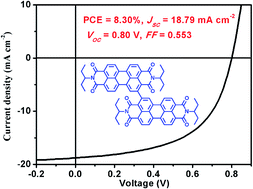A simple molecular structure of ortho-derived perylene diimide diploid for non-fullerene organic solar cells with efficiency over 8%†
Abstract
A simple molecular structure of ortho-derived perylene diimide (PDI) diploid (oo-2PDI), a PDI derivative, as well as two bay-derived PDI diploids (bb-2PDI and bo-2PDI), was designed and efficiently synthesized by efficient Ullmann coupling reactions. The photophysical and electrochemical properties indicate that oo-2PDI exhibits much stronger absorption than bb-2PDI in the visible region and a slightly higher lowest unoccupied molecular orbital (LUMO) level, which are beneficial for harvesting much sunlight and improving open circuit voltage in the organic solar cell (OSC) devices. On using PTB7-Th with appropriate energy level alignment and well matched absorption as the electron donor, the active layer of PTB7-Th:oo-2PDI exhibits a favorable morphology, higher carrier mobilities and more balanced carrier transport. As a result, the device based on PTB7-Th:oo-2PDI shows a power conversion efficiency (PCE) as high as 8.30% and a high short circuit current (JSC) of 18.79 mA cm−2, which are much higher than those of the other two PDI diploids (bb-2PDI and bo-2PDI), highlighting the potential of ortho-derived PDI diploid to realize high efficiency non-fullerene OSCs. Such a concise molecular structure and the high efficiency make this compound promising for practical applications in OSCs.



 Please wait while we load your content...
Please wait while we load your content...